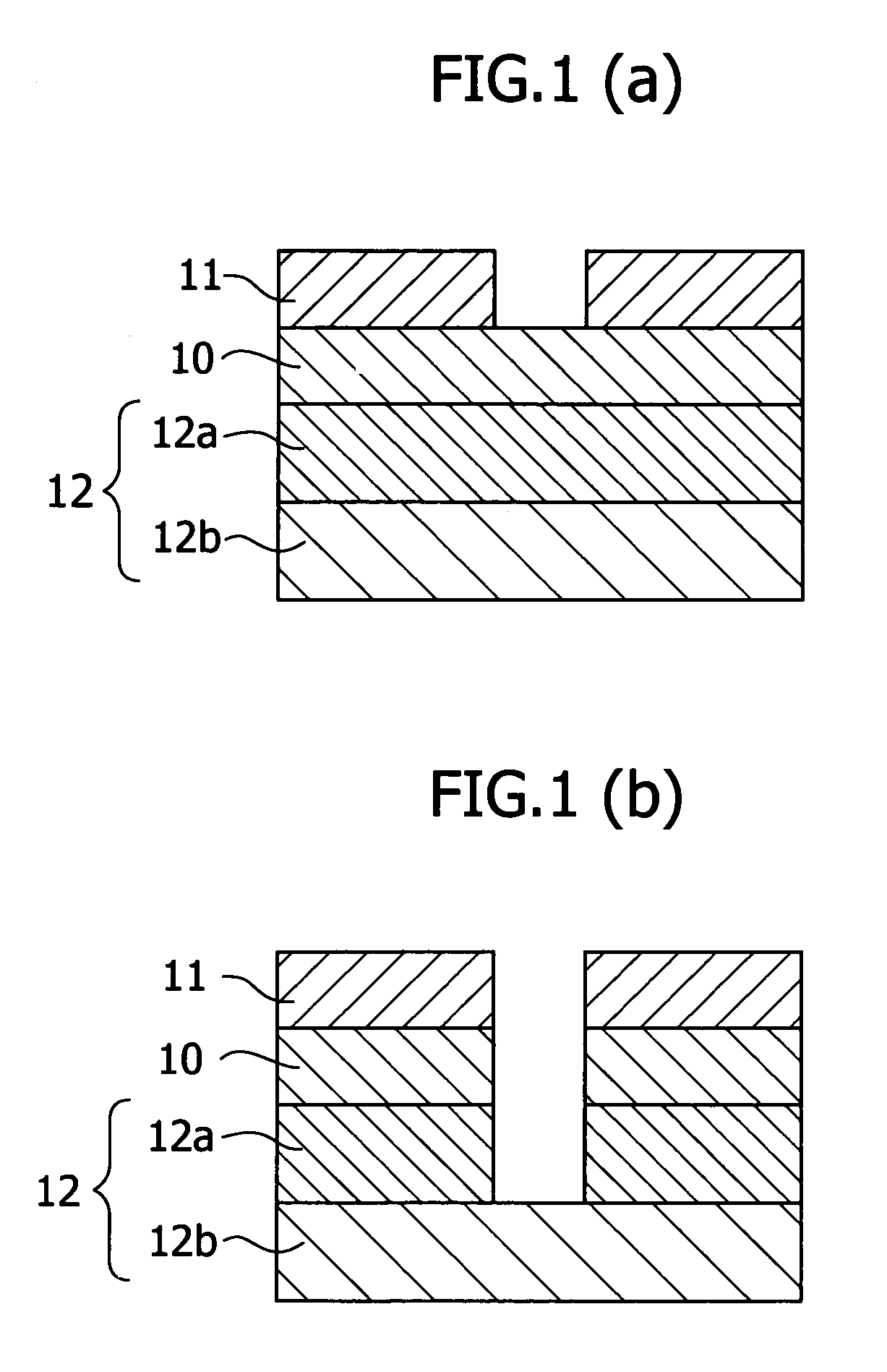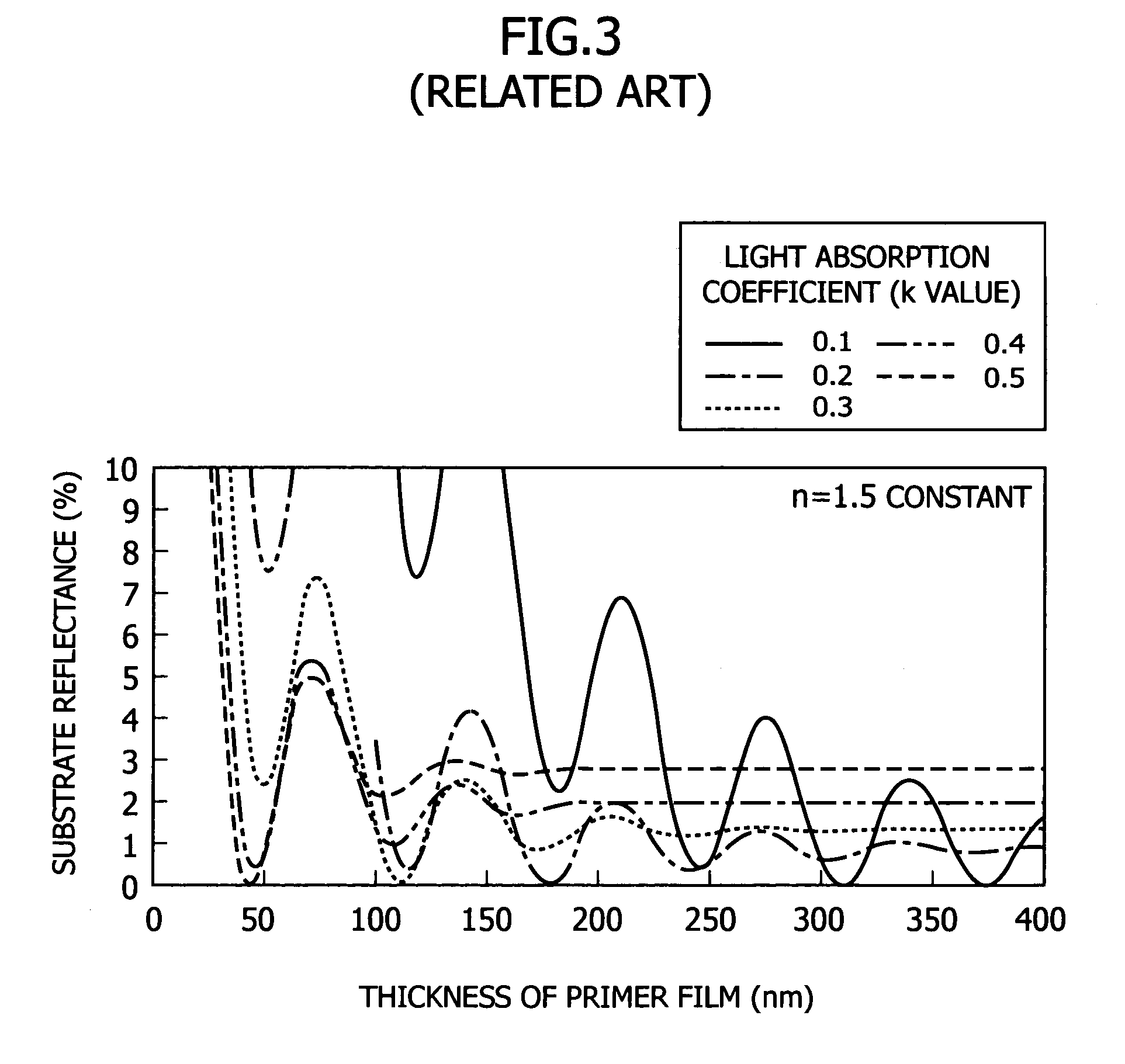Antireflective film material, and antireflective film and pattern formation method using the same
- Summary
- Abstract
- Description
- Claims
- Application Information
AI Technical Summary
Benefits of technology
Problems solved by technology
Method used
Image
Examples
synthesis example 1
[0135]The 1400 g of methanol, 700 g of pure water and 50 g of aqueous 25 wt % solution of tetramethylammonium hydroxide were placed in a 3000 ml glass flask and stirred. To this mixture was added a mixture of 217 g of 3-glycidoxypropyltrimethoxysilane and 43 g of phenyltrimethoxysilane in a dropwise manner at a liquid temperature of 40° C. and then stirred for two hours at 40° C. After reaction was over, 35 g of acetic acid was added to stop the reaction and the methanol was removed by distillation under reduced pressure. The 2000 ml of ethyl acetate was added to the solution thus obtained. After the water phase was removed, the organic liquid phase was washed twice with ultrapure water, and 600 g of propylene glycol monomethyl ether acetate (PGMEA) was added, and under reduced pressure while heating the liquid to a temperature of 40° C., Polymer 1 was obtained.
[0136]The weight-average molecular weight (Mw) was obtained by gel permeation chromatography (GPC) using a polystyrene stan...
synthesis example 2
[0138]The 1400 g of ethanol, 700 g of pure water and 50 g of an aqueous 25 wt % solution of tetramethylammonium hydroxide were placed in a 3000 ml glass flask and stirred. To this mixture was added a mixture of 139 g of 2-(3,4-epoxycyclohexyl)ethyl trimethoxysilane and 32 g of phenyltrimethoxysilane in a dropwise manner at a liquid temperature of 40° C. and then stirred for two hours at 40° C. After reaction was over, 35 g of acetic acid was added to stop the reaction and the ethanol was removed by distillation under reduced pressure. The 2000 ml of ethyl acetate was added to the liquid thus obtained. After the water phase was removed, the organic liquid phase was washed twice with ultrapure water, and 600 g of propylene glycol monomethyl ether acetate (PGMEA) was added, and under reduced pressure while heating the liquid to a temperature of 40° C., Polymer 2 was obtained.
[0139]The weight-average molecular weight (Mw) was obtained by gel permeation chromatography (GPC) using a polys...
synthesis example 3
[0141]The 1400 g of ethanol, 700 g of pure water and 50 g of an aqueous 25 wt % solution of tetramethylammonium hydroxide were placed in a 3000 ml glass flask and stirred. To this mixture was added a mixture of 139 g of 2-(3,4-epoxycyclohexyl)ethyl trimethoxysilane and 32 g of phenyltrimethoxysilane in a dropwise manner at a liquid temperature of 40° C. and then stirred for two hours at 40° C. After reaction was over, 35 g of acetic acid was added to stop the reaction and the ethanol was removed by distillation under reduced pressure. The 2000 ml of ethyl acetate was added to the liquid thus obtained. After the water phase was removed, the organic liquid phase was washed twice with ultrapure water, 1000 g of acetic acid was added, and the ether acetate was removed by distillation under reduced pressure while heating the liquid to a temperature of 40° C. The polymer acetic acid solution thus obtained was stirred for 12 hours at 40° C. Next, 600 g of propylene glycol monomethyl ether ...
PUM
| Property | Measurement | Unit |
|---|---|---|
| Antireflective | aaaaa | aaaaa |
Abstract
Description
Claims
Application Information
 Login to View More
Login to View More - R&D
- Intellectual Property
- Life Sciences
- Materials
- Tech Scout
- Unparalleled Data Quality
- Higher Quality Content
- 60% Fewer Hallucinations
Browse by: Latest US Patents, China's latest patents, Technical Efficacy Thesaurus, Application Domain, Technology Topic, Popular Technical Reports.
© 2025 PatSnap. All rights reserved.Legal|Privacy policy|Modern Slavery Act Transparency Statement|Sitemap|About US| Contact US: help@patsnap.com



